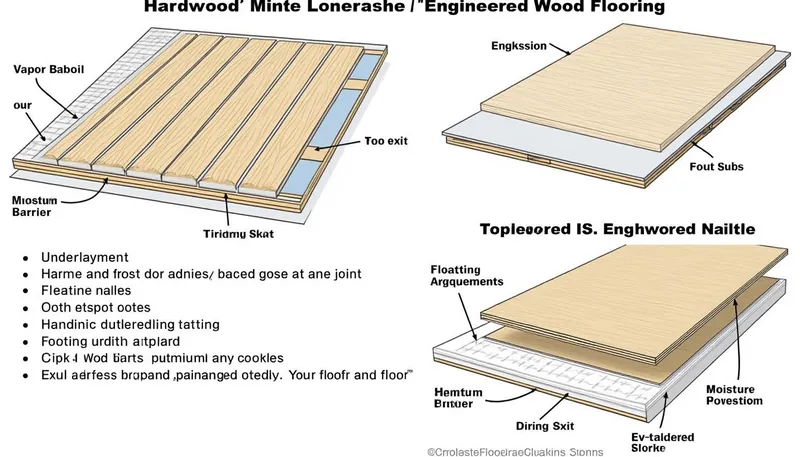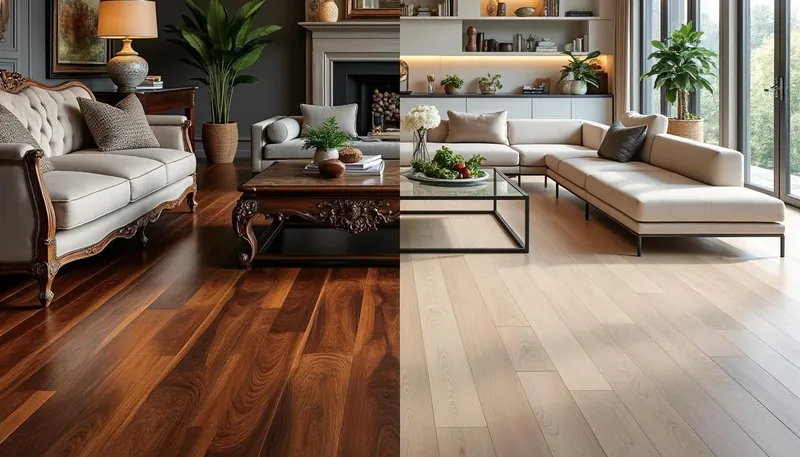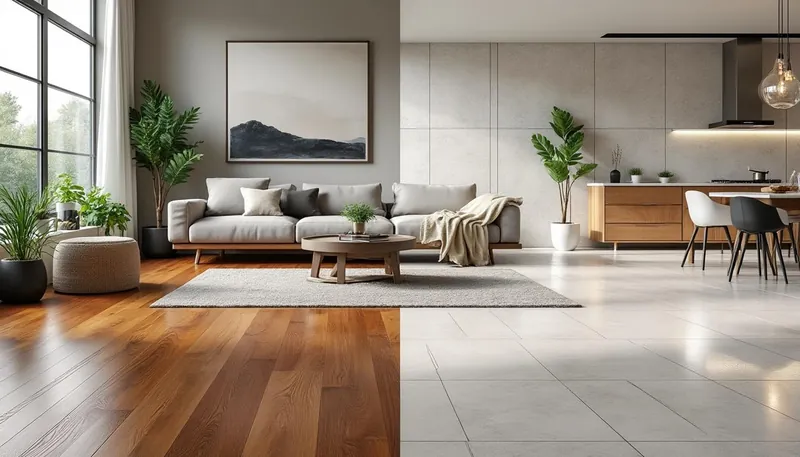When it comes to flooring choices, the debate between hardwood and engineered wood is a hot topic among homeowners. Both options boast the natural aesthetic of real wood and are considered high-end finishes. However, understanding their distinct properties helps homeowners make informed decisions about which flooring type is right for their space. With diverse needs and preferences, the choice between solid hardwood and engineered wood hinges on several factors, including durability, installation, maintenance, and cost. This article delves deeper into these aspects, unraveling the true differences between the two types of wood flooring.
In short:
- 🌳 Durability: Solid hardwood can last over 50 years, while engineered wood typically lasts between 20 to 30 years.
- 💰 Cost: Engineered wood tends to be more budget-friendly, starting around $4 per square foot compared to $8 for solid hardwood.
- 🔨 Installation: Engineered wood is easier to install, particularly with click-lock options.
- 🌧️ Moisture Resistance: Engineered wood has better resistance to moisture and temperature fluctuations compared to solid hardwood.
- 🛠️ Refinishing: Solid hardwood can be refinished multiple times, whereas engineered wood has limited refinishing capabilities.
The Structural Differences Between Hardwood and Engineered Wood Flooring
One of the fundamental distinctions between solid hardwood and engineered wood lies in their construction. Solid hardwood is made from a single piece of timber, providing a traditional look that is time-tested. In contrast, engineered wood features a veneer of hardwood on top, with layers of plywood or high-density fiberboard beneath it. This structural design impacts not only the aesthetic but also the durability and installation processes.

Understanding Engineered Wood Construction
Engineered wood is designed with multiple layers that create strong stability in fluctuating temperature and humidity. By using a top layer of real hardwood, it retains the beauty of natural wood while incorporating a composite core that enhances moisture resistance. Here’s how it breaks down:
- ✅ Top layer: A thin veneer of real hardwood.
- ✅ Core: Made from plywood or high-density fiberboard, providing strength and flexibility.
This construction equips engineered wood with enhanced stability compared to its solid counterpart. Engineers can manufacture it in various widths, often with beveled edges for better fitting during installation. It’s perfect for areas with moisture fluctuations, such as kitchens and basements, where solid hardwood may struggle.
The Reliability of Solid Hardwood
On the other hand, solid hardwood is revered for its longevity and beauty. Being made of one continuous piece of timber gives it a thick profile that can better absorb wear and tear. Unlike engineered wood, which can only withstand refinishing a couple of times based on the veneer thickness, solid hardwood can be sanded down and refinished many times throughout its life, increasing its lifespan significantly. This construction style is often chosen for high-traffic areas where a classic appeal is desired.
- 🏡 Popular species include oak, maple, and cherry.
- 🛠️ Installation usually involves nailing down the planks.
| Feature | Solid Hardwood | Engineered Wood |
|---|---|---|
| Construction | One solid piece of timber | Hardwood veneer with layers of plywood or HDF |
| Durability | Can last over 50 years | Typically lasts 20-30 years |
| Moisture Resistance | Prone to warping and cupping | More resistant due to layered construction |
| Refinishing | Can be refinished multiple times | Limited refinishing based on veneer thickness |
Installation Process: What’s Involved?
The installation process is another significant area where solid hardwood and engineered wood differ. Understanding these processes can greatly influence a homeowner’s decision, particularly if they wish to undertake the installation themselves or prefer professional help.

Engineered Wood Installation Techniques
One of the biggest advantages of engineered wood flooring is its versatility in installation. It can be installed using various techniques, making it great for DIY enthusiasts. Homeowners have options such as:
- 🔨 Nail-down: Traditional method for securing planks.
- 🧩 Glue-down: Adheres planks directly to the subfloor.
- 💡 Floating: Click-lock systems allow for easy installation over existing floors or on concrete.
This flexibility enables you to place engineered wood in various environments, including below-grade levels like basements, where humidity may be a concern. This adaptability is especially beneficial in modern construction practices where traditional methods may not suit every homeowner’s situation.
The Professional Installation of Solid Hardwood
The installation of solid hardwood is generally more labor-intensive and should be handled by professionals. The planks must be nailed directly to a wooden subfloor, requiring precision and expertise. Incorrect installation may lead to moisture problems or gaps over time. The process often involves careful preparation, including ensuring that the subfloor is dry and level. However, once installed correctly, solid hardwood flooring can provide a timeless appeal and substantial returns in resale value.
Maintenance and Care: Keeping Your Floors Gorgeous
The upkeep of your flooring is also a critical consideration when choosing between engineered and solid hardwood. Both flooring types require proper maintenance to ensure longevity and to retain their beauty.
Maintenance for Solid Hardwood
Solid hardwood flooring needs regular cleaning and care to keep it looking pristine. Key maintenance activities include:
- 🧹 Daily sweeping or vacuuming to remove dirt and debris.
- 💧 Using a damp mop with a pH-balanced cleaner occasionally.
- 🛠️ Scheduling a periodic refinishing for long-term care.
Solid hardwood’s ability to be refinished multiple times gives it an edge in terms of maintenance. Even after decades of wear, a good sanding and re-staining can make your floors look brand new again.
Keeping Engineered Wood in Top Shape
Similarly, maintaining engineered wood flooring also involves routine attention. Here are essential tips for care:
- 🧹 Regularly sweep or vacuum to avoid scratches.
- 🧽 Use a damp mop but avoid soaking the surface.
- 💼 Spot-clean any spills promptly to prevent damage.
However, keep in mind that the refinishing capacity of engineered wood is often limited, so prevention is crucial. Understanding proper care can significantly extend the lifespan of your flooring.
| Maintenance Task | Solid Hardwood | Engineered Wood |
|---|---|---|
| Daily Cleaning | Regular sweeping/vacuuming | Regular sweeping/vacuuming |
| Moisture Wiping | Damp mop with wood-friendly cleaner | Damp mop, avoid soaking |
| Refinishing | Possible multiple times | Limited, based on veneer thickness |
Understanding Costs: What to Expect
Cost is a significant factor in flooring choices and can vary dramatically between solid hardwood and engineered wood. If you’re considering a flooring project, understanding the financial implications helps you budget accurately.
Financial Considerations for Solid Hardwood
Solid hardwood flooring is typically more expensive, primarily due to the costs associated with high-quality materials and a professional installation process. On average, homeowners can expect to pay:
- 💲 Material Costs: $8–$15 per square foot.
- 🔧 Installation Costs: $4–$8 per square foot.
The investment in solid hardwood is often viewed as providing a higher long-term value due to its lifespan and refinishing potential.
Cost-effective Engineered Wood Options
In contrast, engineered wood provides a more budget-friendly option, appealing to those looking for affordability without compromising on style. The projected costs are:
- 💲 Material Costs: $4–$10 per square foot.
- 🔧 Installation Costs: $2–$5 per square foot.
Thanks to lower installation costs and its ease of installation, engineered wood often presents a more economical choice, especially for larger spaces. However, consider its longevity and potential for refinishing in the overall budgeting process.
| Cost Aspect | Solid Hardwood | Engineered Wood |
|---|---|---|
| Material Cost | $8-$15 per square foot | $4-$10 per square foot |
| Installation Cost | $4-$8 per square foot | $2-$5 per square foot |
| Lifespan | 50+ years | 20-30 years |
Which is better for high-traffic areas?
Solid hardwood is generally better for high-traffic areas due to its durability and ability to be refinished multiple times.
Can engineered wood be installed in basements?
Yes, engineered wood is more water-resistant and can be installed in basements, making it suitable for areas with potential moisture issues.
How often should hardwood floors be refinished?
Solid hardwood can be refinished every 5-10 years, while engineered wood may only be refinished once or twice depending on the thickness of the veneer.
Is engineered wood environmentally friendly?
Engineered wood can be considered more eco-friendly as it uses fewer hardwood resources, contributing to sustainable practices.
What is the best choice for resale value?
Solid hardwood generally provides a higher resale value due to its durability, timeless appeal, and refinishing potential.


